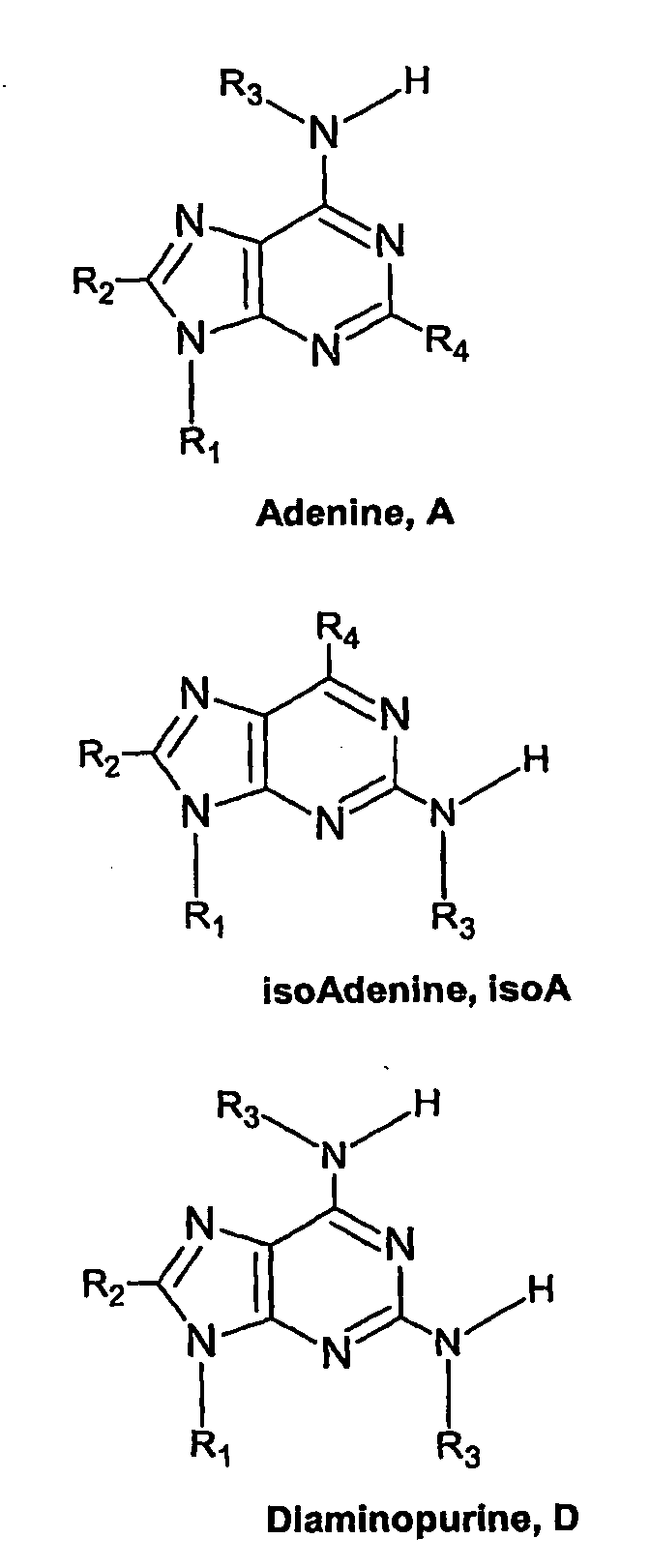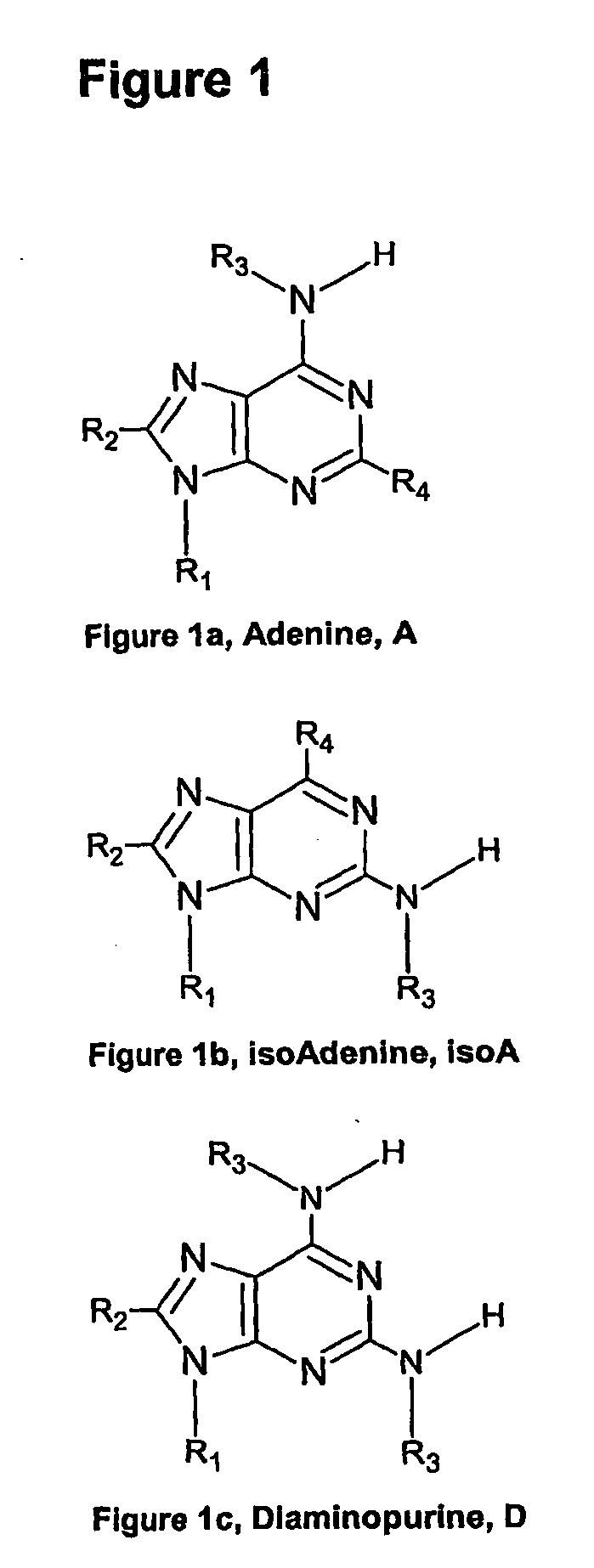Nucleic acid base pairs
a technology of base pairs and nucleic acids, applied in the preparation of carboxylic acid amides, organic chemistry, instruments, etc., can solve the problems of limited use of dna and pna, limited use of a base pairing oligomer's self-structure, and high self-aggregation of pna, so as to increase inter and intra-molecular interactions, reduce solubility, and high self-aggregation
- Summary
- Abstract
- Description
- Claims
- Application Information
AI Technical Summary
Benefits of technology
Problems solved by technology
Method used
Image
Examples
example 1a
Preparation of Pyrimidinone-Monomer
[0216]1. In dry equipment 4.6 g of solid Na in small pieces was added to 400 mL ethanol (99.9%), and was dissolved by stirring. Hydroxypyrimidine hydrochloride, 13.2 g, was added and the mixture refluxed for 10 minutes. Then 12.2 mL ethyl-bromoacetate (98%) was added and the mixture refluxed for 1½ hour. The reaction was followed using Thin Layer Chromatography (TLC). The ethanol was evaporated leaving a white compound, which was dissolved in a mixture of 80 mL of 1M NaCitrate (pH 4.5) and 40 mL of 2M NaOH. This solution was extracted four times with 100 mL Dichloromethane (DCM). The DCM phases were pooled and washed with 10 mL NaCitrate / NaOH-mixture. The washed DCM phases were evaporated under reduced pressure and resulted in 17.2 g of crude solid product. This crude solid product was recrystallized with ethylacetate giving a yellow powder. The yield for this step was 11.45 g (63%).
[0217]2. The yellow powder, 12.45 g. from above was hydrolyzed by ...
example 1b
Alternative Method of Preparing Pyrimidinone Monomer
[0220]Step 1. In dry equipment 9.2 g of solid Na in small pieces was dissolved in 400 mL ethanol (99.9%), with stirring. Hydroxypyrimidine hydrochlorid, 26.5 g, was added, and the mixture was stirred for 10 minutes at 50° C. Then 24.4 mL Ethyl bromoacetate (98%) was added and the mixture stirred at 50° C. for 1 hour. The reaction was followed using Thin Layer Chromatography (TLC).
[0221]The ethanol was evaporated leaving a white compound, which was dissolved in 70 mL of water and extracted with 20 mL DCM. Another 30 mL of water was added to the water phase, which was extracted with 3×100 mL DCM. The DCM-phase from the first extraction contains a lot of product, but also some impurities, wherefore this phase was extracted twice with water. These two water phases then were back extracted with DCM.
[0222]The combined DCM phases were pooled and washed with 10 mL water. The washed DCM phases were evaporation under reduced pressure and res...
example 2
Preparation of Thio-Guanine Monomer
[0228]1. 6-Chloroguanine (4.93 g) and 10.05 g K2CO3 was stirred with 40 mL DMF for 10 minutes at room temperature. The reaction mixture was placed in a water bath at room temperature and 3.55 mL ethyl bromoacetate was added. The mixture was stirred in a water bath until TLC (20% Methanol / DCM) showed that the reaction was finished. The precipitated carbonate was filtered off and washed twice with 10 mL DMF. The solution, which was a little cloudy, was added to 300 ml water, whereby it became clear. On an ice bath the target compound slowly precipitated. After filtration the crystals were washed with cold ethanol and dried in a desiccator. The yield for this step was 3.3 g (44.3%) of ethyl chloroguanine acetate.
[0229]2. Ethyl chloroguanine acetate (3.3 g) was dissolved by reflux in 50 mL absolute ethanol. Thiourea (1.08 g) was added. After a refluxing for a short time, precipitate slowly began forming. According to TLC (20% Methanol / DCM) the reaction...
PUM
| Property | Measurement | Unit |
|---|---|---|
| Volume | aaaaa | aaaaa |
| Volume | aaaaa | aaaaa |
| Volume | aaaaa | aaaaa |
Abstract
Description
Claims
Application Information
 Login to View More
Login to View More - R&D
- Intellectual Property
- Life Sciences
- Materials
- Tech Scout
- Unparalleled Data Quality
- Higher Quality Content
- 60% Fewer Hallucinations
Browse by: Latest US Patents, China's latest patents, Technical Efficacy Thesaurus, Application Domain, Technology Topic, Popular Technical Reports.
© 2025 PatSnap. All rights reserved.Legal|Privacy policy|Modern Slavery Act Transparency Statement|Sitemap|About US| Contact US: help@patsnap.com



